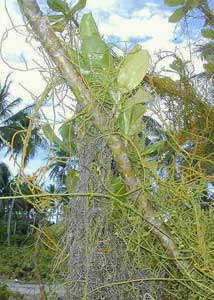|
Description: This thin stemmed native, coastal vine is parasitic, herbaceous, and leafless. Kaōnōn produces tiny greenish-white flowers clustered on short spikes. Its small fruits are round and fleshy. Its string-like stems are pale green to yellow or orange. They attach themselves to other plants by suckers (haustoria) that take nutrients from the host plant. Thus this plant is a parasite. The many thin stems of kaōnōn form dense, tangled mats that can completely cover a host plant. |
Uses: The stem serves as a filter to strain makmōk (arrowroot) by helping to separate the useless residue from the real food of the crop after it has been grated. The stems are also woven into ut (garlands). Kaōnōn has medicinal properties too. For example, during labor a pregnant woman may bathe in water in which pounded kaōnōn stems have been squeezed; this bath is said to provide the pregnant woman with strength and to reduce the pain of delivery. Pounded parts of this plant are also mixed into a potion that is applied to jellyfish stings. The pounded parts of kaōnōn mixed with water are also used as a shower to restore memory or cure other mental problems. According to Marshallese traditional belief, kaōnōn is used as protection from demons. For example, if one has to sleep alone in an isolated place, protection from demons can be obtained by covering oneself with kaōnōn.

|
Distribution: Kaōnōn vines are widespread, found throughout the tropics of the world. They spread out over the ground and the low-lying plants in the strand vegetation, or sometimes cover shrubs and even small trees with their dense masses of orange stems.

|

